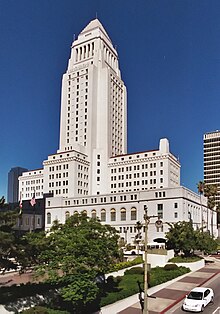
Back قاعدة العزل Arabic Aïllament sísmic Catalan Aislamiento sísmico Spanish جداسازی پایه Persian Isolement bas French Isolatore sismico Italian 免震 Japanese Сейсмическая изоляция Russian Base isolation SIMPLE Deprem yalıtımı Turkish
This article needs additional citations for verification. (May 2010) |



Seismic base isolation, also known as base isolation,[3] or base isolation system,[4] is one of the most popular means of protecting a structure against earthquake forces.[5] It is a collection of structural elements which should substantially decouple a superstructure from its substructure that is in turn resting on the shaking ground, thus protecting a building or non-building structure's integrity.[6]
Base isolation is one of the most powerful tools of earthquake engineering pertaining to the passive structural vibration control technologies. The isolation can be obtained by the use of various techniques like rubber bearings, friction bearings, ball bearings, spring systems and other means. It is meant to enable a building or non-building structure to survive a potentially devastating seismic impact through a proper initial design or subsequent modifications. In some cases, application of base isolation can raise both a structure's seismic performance and its seismic sustainability considerably. Contrary to popular belief, base isolation does not make a building earthquake proof.
Base isolation system consists of isolation units with or without isolation components, where:
- Isolation units are the basic elements of a base isolation system which are intended to provide the aforementioned decoupling effect to a building or non-building structure.
- Isolation components are the connections between isolation units and their parts having no decoupling effect of their own.
Isolation units could consist of shear or sliding units.[7][unreliable source?][8][unreliable source?]
This technology can be used for both new structural design[9] and seismic retrofit. In process of seismic retrofit, some of the most prominent U.S. monuments, e.g. Pasadena City Hall, San Francisco City Hall, Salt Lake City and County Building or LA City Hall were mounted on base isolation systems. It required creating rigidity diaphragms and moats around the buildings, as well as making provisions against overturning and P-Delta Effect.
Base isolation is also used on a smaller scale—sometimes down to a single room in a building. Isolated raised-floor systems are used to safeguard essential equipment against earthquakes. The technique has been incorporated to protect statues and other works of art—see, for instance, Rodin's Gates of Hell at the National Museum of Western Art in Tokyo's Ueno Park.[10]

Base isolation units consist of Linear-motion bearings, that allow the building to move, oil dampers that absorb the forces generated by the movement of the building, and laminated rubber bearings that allow the building to return to its original position when the earthquake has ended.[11]
- ^ "Los Angeles City Hall Seismic Rehabilitation Project – Base Isolation Technology". Archived from the original on 27 July 2011.
- ^ "Nabih Youssef Associates | Structural Engineers". www.nyase.com. Retrieved 2017-06-11.
- ^ Pressman, Andy (2007). Architectural Graphic Standards. John Wiley and Sons. p. 30. ISBN 978-0-471-70091-3.
- ^ Webster, Anthony C. (1994). Technological Advance in Japanese Building Design and Construction. American Society of Civil Engineers. p. 70. ISBN 978-0-87262-932-5.
- ^ Datta, T. K. (2010). Seismic Analysis of Structures. John Wiley and Sons. p. 369. ISBN 978-0-470-82462-7.
- ^ "Base isolation: video demonstration". Archived from the original on 2021-12-12 – via www.youtube.com.
- ^ Lead Rubber Bearing being tested at the UCSD Caltrans-SRMD facility, YouTube
- ^ Hybrid Simulation of Base Isolated Structures, YouTube
- ^ "Projects". www.siecorp.com.
- ^ Reitherman, Robert (2012). Earthquakes and Engineers: An International History. Reston, VA: ASCE Press. ISBN 9780784410622.
- ^ "Seismic Isolation | [ THK || Global English ]". www.thk.com.